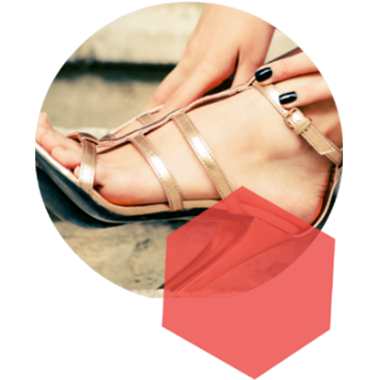Cracked heels can occur for a number of reasons, from lacking enough moisture to exposing footwear. If you’ve noticed symptoms such as dry skin thickening around your heels, or have cracked skin or heel pain, then knowing the causes can help you understand the condition, and could prevent further relapses from happening.
A wide range of different causes
There are several potential causes of cracked heels. Take a look at your routine, and if you identify anything below that may be affecting you, then try altering your current habits. Here are the most common causes of cracked heels:
- Lacking moisture – This is the most common cause of cracked heels. The skin underneath your feet is often dry, rough and chapped. This is because the skin around your heels has a relatively small number of sweat glands. If your skin is particularly dry, then cracked skin appears more easily due to there being less elasticity and can be exacerbated by any of the below problems.
- Deficiencies – Lack of vitamins, minerals and zinc in your diet can adversely affect your heel health.
- Pressure – Spending a long time standing at work or home can stress the skin on your heels.
- Aging skin – Thick, dry, scaly skin loses its elasticity with age, and as such cracks can have higher incidence as you become older.
- Disorders – Athlete’s foot, psoriasis, eczema, thyroid disease, diabetes and some other skin conditions can be the cause of cracked heels.
- Obesity – Being overweight can increase the pressure on the fat pad under the heel. This can cause it to expand sideways and, if the skin lacks flexibility, put pressure on the feet. This leads to cracked heels.
- Exposing footwear – Open-back sandals or shoes can allow fat under the heel to expand sideways and increase the possibility of cracks on your heels. Taking care of your feet regularly is important when wearing footwear that exposes your heels.
- Hygiene – Failing to keep your feet adequately clean can be a further cause of cracked heels.
- Water – Water on your feet can take away natural oils from the skin and can leave the skin rough and/or dry. Standing for prolonged periods in damp areas, such as a bathroom, can cause dry and cracked heels.
- Poor fitting shoes – Wearing shoes that do not fit properly can contribute to cracked heels.
- Genetics – Naturally dry or thick, dry skin (callus) around the heel could be a genetic cause of cracked heels.
Cracked heels are caused when the skin around your heels splits apart. A mixture of dryness and pressure lead to cracked heels, as the skin becomes unable to keep up moisture levels and ultimately becomes fragile, leading to breaks.
Boosting foot hygiene with moisturizers and cleansers can help keep skin supple. Amopé Pedi Perfect™ Daily Moisturizer uses Vitamin B3 and a blend of oils to provide your feet with moisture for up to 24 hours. Try it, and see if your cracked heels improve (please see on-pack directions for additional product information). Another tip might be to change your diet to one which includes foods rich in calcium, iron and zinc. In many cases, this can help boost skin health , although it’s best to check with your doctor first before making diet alterations.
If you find that your symptoms persist even after treatment, speak to your doctor or dermatologist to find out if there might be any other potential causes or underlying health problems.



